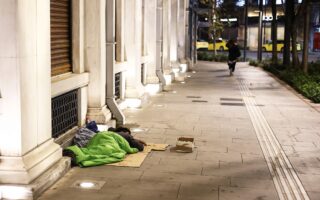Athens’ tourism miracle getting warped in the heat
Prolonged period of very high temperatures can, over time, cause a shift in the capital’s ‘high season,’ while other problems persist too

A veteran hotelier in Athens used to say, “Tourism is like a storm; for three years you might ride high on the waves and for the next two, you struggle to keep your head above water.” However, tourism in Athens after the Covid-19 pandemic is like a surfing competition in Hawaii: setting record after record, dazzling the audience with achievements and dynamism, and paying no attention to anything that might compromise the acrobatics on the wave.
However, a walk through the streets of this tiny Athenian “Disneyland,” from the Commercial Triangle and Syntagma Square to Plaka and the edges of the Koukaki neighborhood, reveals that clouds are not entirely absent from the horizon. This summer has tested the patience and resilience of both residents and visitors. Despite the theoretical growth of the Athenian tourism industry, it still faces significant challenges. Public space is lamentable (except for the Great Promenade at the foot of the Acropolis), there is a near-constant sense of disorder, noise pollution, inconsistent cleanliness (depending on the last garbage collection), various forms of visual pollution and an outdated, overwhelming dominance of private cars over greener transportation options (giving the impression that the city belongs in the Middle East or North Africa rather than Europe). These aspects form the most glaring part of the condensed experience of a well-intentioned three- to four-day visitor.
Clued-in visitors
The new elephant in the room, however, is not the graffiti, the tiny sidewalks and the dirt. According to an annual survey by the Athens-Attica & Argosaronic Hotel Association, in collaboration with GBR Consulting, tourist satisfaction with Athens has been steadily increasing, reaching 8.4 last year compared to 7.7 in 2017. “Most foreigners won’t complain about these issues. They expect it, they are not surprised, they’ve done their research, they know where they are going. Besides, some come specifically to experience a bit of Athenian chaos before returning to their tidy and, as they might think, somewhat ‘humdrum’ city,” says Savvas, an employee and guide at a bicycle and soft mobility rental company in Makriyianni, who declined to give his surname. The new elephant in the room is the successive heatwaves.

Typically, a tourist destination’s appeal is damaged by extraordinary events: a terrorist act, an economic recession, a pandemic. Athens has experienced all three and recovered faster than predicted. Today, as the capital leads the resurgence of Greek tourism, a new threat emerges from well, almost, nowhere. Although environmental experts have been warning for years, no one imagined that climate change would become a direct experience for the first generations of the 21st century.
“It’s one thing for a summer to be hotter than usual and another to develop a shared experience of successive hot summers that can lead to changes in established habits and year-long planning,” says Elias Kikilias, general manager of INSETE, the Institute of the Greek Tourism Confederation (SETE). He predicts a “seasonal adjustment” in the long term if the climatic trends of this and last summer persist and become permanent. Are we at this point? “Not yet fortunately. But if a belief is established in our key markets abroad about Mediterranean summers, we may see shifts that will shake the fundamental dogmas of both Greek and Athenian tourism markets.” One such belief is that June and July are traditionally the most “productive” months for Athens. Why shouldn’t that change, leading to increased arrivals in traditionally low periods like December and January? However, such a significant shift is not simple. For instance, schools close in the summer. Speaking with hotel industry stakeholders reveals no such concern yet.

City hotels are experiencing perhaps the best summer in the history of Athenian tourism. “What a shame they can’t enjoy it as much as they’d like!” says one of the most experienced hoteliers. “When the thermometer stays at 36 or 37C for days, older visitors especially are practically excluded from a range of activities from noon until late afternoon, the most productive part of their day. Moreover, the heat affects city tourism more and impacts older tourists, who usually spend more.” In the first five months of 2024, Athens hotels reported an average occupancy rate of 72.3% compared to 68.9% in 2023. Despite achieving a higher occupancy rate this May (86.2%) than the previous months, there is a minor blemish: a 2.7% decrease compared to May 2023.
Heat day and night
“We are experiencing a summer that is climatologically extreme for our region,” says Kostas Lagouvardos, research director at the National Observatory of Athens. Greece just experienced its hottest winter since records began. “Consider that since July 2023, we have had 12 consecutive months with temperatures slightly or significantly above normal levels, except for May. June was extremely hot, and July is following the same pattern.” Lagouvardos points out that the problem for Athens and other tourist destinations is not just the heat itself but its duration. “If we look at June, we will see that in Athens, temperatures only exceeded 40C for one day. The problem was that almost every other day of the month, the temperature was well above normal levels, intensifying the feeling of heat. It’s the duration that makes people tired and exhausted.”
Although Athens and Attica have always had hot summers, their climate, thanks to the northern-northeastern winds (known locally as “meltemia”), was relatively more bearable compared to areas without the benefit (and curse, at the same time, due to wildfires) of the north wind and low humidity. “This mainly applies to the northern suburbs and the eastern coast and not so much to the city center or the south,” says Lagouvardos. “In those areas, the temperature does not drop satisfactorily even at night. If a tourist can be patient during the day and waits for relief at night, and this relief does not come because the temperature remains around 31 or 32C near midnight, then the feeling of discomfort increases even more.”

One could argue that the general state of public spaces in central Athens has improved – not compared to other large cities in southern Europe (such as Rome, Madrid or Lisbon), but compared to Athens in 2015 or 2020. The number of motorcycles and cars blocking pedestrian and disabled crossings is smaller, and the sight of shut-down shops conveying a sense of abandonment and economic anxiety is more limited. Additionally, there are more underground garbage bins, promising a more decent future, and greater efforts are made to show our good side where we feel more exposed.
However, the overall picture remains below the European average. The unresolved traffic chaos with tourist buses on Amalias Avenue and the narrow side streets of Syngrou Avenue is a characteristic case, though one of the more complicated ones. “For so many years, we haven’t been able to solve the issue with parked cars on Solonos or even Panepistimiou streets. How could we possibly expect to solve the much more serious problem caused by the tourist coaches?” asks a hotel market insider who operates on the outskirts of Plaka. The ingrained culture of lack of control and general impunity also poisons Athens’ tourism product. How can any well-intentioned tourist bus management study come to fruition when the Athenian driver knows they can park anywhere in the city center for five or 10 minutes without any repercussions? Have we wondered why we insist on driving to Syntagma Square in our cars, demanding parking spaces when the infrastructure is lacking, while in most European cities such a thought would be simply prohibitive? It is because the municipality and the state are telling us, in their way, that we (still) can.
Sidewalks
Walking along basic tourist routes, one can see areas where improvement has been made, as well as the opposite. In the first category (comparatively, always) is the general sense of public space, though there are structural problems that condemn Athens to low scores. The center of Athens is overall more walkable compared to its neighborhoods and suburbs. This is due to the significant increase in the number of pedestrian streets since the 2004 Olympics and a relatively modest policy of discouraging private car use. Additionally, during the previous municipal administration, a serious effort was made to combat the so-called “hard” dirt that has permeated the city’s sidewalks and squares. Considerable amounts were spent on purchasing the appropriate equipment. The same applies to the battle against graffiti and tags that have become a sort of upper skin in Athens. It is imperative that the new municipal administration continues on the same path to prevent a return to the situation of a decade ago. The reconstruction of many kilometers of sidewalks is a welcome initiative, improving the daily life of residents and visitors. However, an inexplicable timidity is observed: walking on the new sidewalks of Ermou Street in Monastiraki, near the square, and on Eratosthenous Street in Pangrati, in the direction of the Goulandris Museum, it is striking that their width remains tiny and hostile to pedestrians and the disabled. In terms of accessibility, despite good intentions, Athens continues to score very low.

Green spaces
In contrast, significant progress has been made in clearing the city’s hills of dry vegetation and anything that could contribute to the spread of a fire. Most green spaces are in much better condition compared to the recent past. That said, the perfect is the enemy of the good.
Progress in some areas has come with backward steps in others. Finding a public space that meets the standards of advanced European cities is challenging. Look at the broken marble elements from the grates of the new trees planted on the lower side of Syntagma Square to get an idea. A more serious problem is the expansion of tables and chairs on sidewalks, pedestrian streets and squares during the post-pandemic period. The recent corruption case within the Municipal Police, involving Culture Ministry employees, explains much about the outrageous things we see on the streets of Athens.






